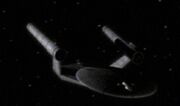Template:Realworld
Ralph McQuarrie Enterprise concept painting
Star Trek: Planet of the Titans (alternatively called Star Trek: Planet of Titans) was to have been the first motion picture based on the Star Trek: The Original Series. It was one of several early attempts to bring Star Trek back after the series had been canceled. The film was in development from 1976 through 1977 before being abandoned.
Summary
Set after the five-year mission depicted in the series, the film involved Starfleet competing with the Klingons for claim to the supposed homeworld of the mythical Titans, a technologically-advanced race long thought extinct. As the planet is pulled into a black hole, the USS Enterprise must also face off against the Cygnans, the alien race responsible for the Titans' disappearance. Ultimately, Captain Kirk is forced to take the Enterprise into the black hole to defeat the Cygnans, a decision that sends the starship and its crew backwards in time thousands of years and into orbit around Earth. After introducing fire to the primitive Humans living at the time, Kirk and his crew are revealed to be the legendary Titans.
History

Concept USS Enterprise study model designed by Ken Adam and Ralph McQuarrie for Planet of the Titans. It was eventually seen in the Earth Spacedock in Star Trek III: The Search for Spock, and later in "Unification I" as the "B-24-CLN".
The film was to be produced in England, with Jerry Isenberg serving as executive producer. Hired to direct the film was Philip Kaufman, later known for directing such films as Invasion of the Body Snatchers (starring Leonard Nimoy), The Right Stuff, and The Unbearable Lightness of Being.
Ken Adam of James Bond fame was hired to be the film's production designer. Adam, sketched new concepts for the starship Enterprise featuring a flattened triangular engineering hull. Artist Ralph McQuarrie, of Star Wars fame, was hired to do conceptual drawing and paintings, featuring variations on Adam's Enterprise, many of which were speculative images not based on the then-unfinished script, such as images of the starship approaching an inhabited asteroid. (The Art of Ralph McQuarrie)
British writers Chris Bryant and Allan Scott wrote the initial fifteen-to-twenty page treatment which, upon acceptance from Paramount Pictures, they turned into a screenplay, which was submitted on 1 March 1977. The following month, the script was rejected by Paramount. Kaufman then took on the task of writing the script, in which he wanted to focus on Spock and a Klingon character he envisioned being played by legendary Japanese actor Toshiro Mifune. Jaufman's script was never completed, as Paramount pulled the plug in May, just weeks before the release of Star Wars. Initially budgeted at $7.5 million, the film had an estimated budget of $10 million at the time project was halted.
While the actual reasons for Paramount abandoning the project are unknown, most likely it is because the executives didn't like either Bryant and Allen's or Kaufman's scripts. Some speculate that the studio thought moviegoers had had their fill of science fiction after Star Wars became a huge box office hit, but that the subsequent success of Close Encounters of the Third Kind altered their thinking: but this is mere speculation without evidence to back it up.
Planet of the Titans was shelved and never revisited. Paramount next moved ahead with a proposed Star Trek: Phase II TV series, which, eventually, became Star Trek: The Motion Picture.
Study Models
Several small study models of the Enterprise designs were created during the project's short life. Two eventually appeared in later Star Trek productions: one partially visible behind the hub of the Spacedock in Star Trek III, and both appeared in the "Starship Graveyard" scene in the aftermath of the Battle of Wolf 359 on The Next Generation. These models and are often mistakenly reported as Enterprise designs for Star Trek: Phase II.
Template:UndevelopedSpinOffs
